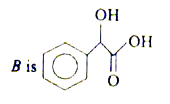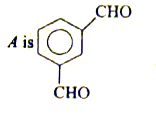How many isomer of C4H8O when reacts with CH3MgBr followed by acidification to give 2∘ alcohol (only consider carbonyl isomers) ?
(including stereoisomer)
The correct Answer is:2
To determine how many isomers of C₄H₈O can react with CH₃MgBr followed by acidification to yield a secondary alcohol, we will follow these steps:
Step 1: Identify the possible carbonyl isomers of C₄H₈O.
The molecular formula C₄H₈O indicates that we are dealing with either aldehydes or ketones, as these are the carbonyl compounds. The possible carbonyl isomers of C₄H₈O include:
1. Butanal (an aldehyde)
2. 2-Butanone (a ketone)
3. 3-Butanone (a ketone)
4. Cyclobutanone (a cyclic ketone)
Step 2: Determine which of these isomers can yield a secondary alcohol upon reaction with CH₃MgBr.
A secondary alcohol is formed when the carbon atom bonded to the hydroxyl group (OH) is attached to two other carbon atoms. Let's analyze each isomer:
1. Butanal:
- Reaction: Butanal (C₃H₇CHO) reacts with CH₃MgBr to form a secondary alcohol.
- Product: Butanol (C₄H₉OH) - This is a primary alcohol, so it does not count.
2. 2-Butanone:
- Reaction: 2-Butanone (C₄H₈O) reacts with CH₃MgBr.
- Product: 2-Butanol (C₄H₉OH) - This is a secondary alcohol, so it counts.
3. 3-Butanone:
- Reaction: 3-Butanone (C₄H₈O) reacts with CH₃MgBr.
- Product: 3-Butanol (C₄H₉OH) - This is also a secondary alcohol, so it counts.
4. Cyclobutanone:
- Reaction: Cyclobutanone (C₄H₈O) reacts with CH₃MgBr.
- Product: A secondary alcohol is formed, as the carbonyl carbon is bonded to two other carbons in the ring.
Step 3: Count the isomers that yield secondary alcohols.
From our analysis:
- 2-Butanone yields 2-Butanol (secondary alcohol).
- 3-Butanone yields 3-Butanol (secondary alcohol).
- Cyclobutanone yields a secondary alcohol.
Step 4: Consider stereoisomers.
For both 2-Butanol and 3-Butanol, we can have stereoisomers due to the presence of chiral centers:
- 2-Butanol has one chiral center, leading to two stereoisomers (R and S).
- 3-Butanol also has one chiral center, leading to two stereoisomers (R and S).
- Cyclobutanone does not have any stereocenters.
Final Count:
- 2-Butanol: 2 stereoisomers
- 3-Butanol: 2 stereoisomers
- Cyclobutanone: 1 isomer (no stereoisomers)
Thus, the total number of isomers that yield secondary alcohols is:
- 2 (from 2-Butanol) + 2 (from 3-Butanol) + 1 (from Cyclobutanone) = 5 isomers.
Conclusion:
The total number of isomers of C₄H₈O that can react with CH₃MgBr followed by acidification to give a secondary alcohol is 5.
---
The molecular formula C₄H₈O indicates that we are dealing with either aldehydes or ketones, as these are the carbonyl compounds. The possible carbonyl isomers of C₄H₈O include:
1. Butanal (an aldehyde)
2. 2-Butanone (a ketone)
3. 3-Butanone (a ketone)
4. Cyclobutanone (a cyclic ketone)
A secondary alcohol is formed when the carbon atom bonded to the hydroxyl group (OH) is attached to two other carbon atoms. Let's analyze each isomer:
- Reaction: Butanal (C₃H₇CHO) reacts with CH₃MgBr to form a secondary alcohol.
- Product: Butanol (C₄H₉OH) - This is a primary alcohol, so it does not count.
- Reaction: 2-Butanone (C₄H₈O) reacts with CH₃MgBr.
- Product: 2-Butanol (C₄H₉OH) - This is a secondary alcohol, so it counts.
- Reaction: 3-Butanone (C₄H₈O) reacts with CH₃MgBr.
- Product: 3-Butanol (C₄H₉OH) - This is also a secondary alcohol, so it counts.
- Reaction: Cyclobutanone (C₄H₈O) reacts with CH₃MgBr.
- Product: A secondary alcohol is formed, as the carbonyl carbon is bonded to two other carbons in the ring.
From our analysis:
- 2-Butanone yields 2-Butanol (secondary alcohol).
- 3-Butanone yields 3-Butanol (secondary alcohol).
- Cyclobutanone yields a secondary alcohol.
For both 2-Butanol and 3-Butanol, we can have stereoisomers due to the presence of chiral centers:
- 2-Butanol has one chiral center, leading to two stereoisomers (R and S).
- 3-Butanol also has one chiral center, leading to two stereoisomers (R and S).
- Cyclobutanone does not have any stereocenters.
- 2-Butanol: 2 stereoisomers
- 3-Butanol: 2 stereoisomers
- Cyclobutanone: 1 isomer (no stereoisomers)
- 2 (from 2-Butanol) + 2 (from 3-Butanol) + 1 (from Cyclobutanone) = 5 isomers.
The total number of isomers of C₄H₈O that can react with CH₃MgBr followed by acidification to give a secondary alcohol is 5.
Similar Questions
Knowledge Check
How many meso isomers of C4H8Cl2 will be there ?
A0B1C2D3Compound (A) C8H6O2 on treatment with aq. NaOH followed by acidification gives (B) C3H2O3 which on oxidation gives benzoic acid only:
A B
B C
C D
D
How many carbonyl isomers of C5H10O which reacts with PhMgBr to give racemic mixture ?
View SolutionHow many isomers of C4H10O reacts with Na metal to evolve H2 gas ? (excluding stereoisomer)
View SolutionHow many coulomb are required for the oxidation of 1 mol of H2O2→O2?
View SolutionHow many carbonyl isomers will C5H10O have? Give their structures and IUPAC names
View SolutionHow many carbonyl isomers will C5H10O have? Give their structures and IUPAC names
View SolutionHow many carbonyl isomers will C5H10O have? Give their structures and IUPAC names
View Solution